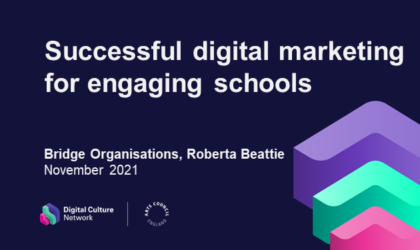
Beginner Read Webinars Digital Marketing Digital Strategy
A panel conversation discussing how arts and culture organisations can more successfully engage schools with digital, blended or in-person cultural offers.
In this article
Head of Creative Programmes, Lucy Bayliss, explains how DanceEast employed digital technology to get their dance programmes into classrooms.
DanceEast is a dance organisation, based in Ipswich, working locally, regionally and nationally. We are funded through a combination of public funds, earned income and grant funding. We have a very broad programme which spans:
Our outreach work focusses on groups and individuals facing disadvantage, children both in and outside education settings, and an innovative range of partnerships to enhance our reach. Over the past 5-6 years we have been developing some cutting-edge work using creative technologies.
I’m Lucy Bayliss, Head of Creative Programmes, and my role is to oversee the creation and delivery of our programme. I lead on new partnership development as well as our work with technology.
In 2016 we started to develop new ambitions for our schools’ programme. After seeing poor-quality provision of dance in primary classrooms, we wanted to do something about it. It was clear that technology would enable us to access more children and deliver more high-quality dance in schools. This would include harder to reach remote, small and rural schools.
We experimented with a range of approaches and online platforms, through a grant from the Paul Hamlyn Foundation. Eventually we settled on a then little-known platform called Zoom and started developing a pedagogy for co-teaching between artists on the screen and teachers in the classroom.
We could see the potential of scaling the model to reach multiple schools at one time. With that in mind, we decided on the Science curriculum as a focus for our initial investigations and model development. However, we could also immediately see the potential application of our approach across topics, curriculum subjects and artforms.
The schools we are working with are all cultural champions in some way. They are a combination of local schools with whom we already had a relationship, and some schools new to us. The new schools are engaging with support from their Multi-academy Trusts (MATs). We specifically identified MATs that we knew were supporting of cultural activity. To ensure we seek out and nurture relationships with schools championing culture, we also sit on several Local Cultural Education Partnerships.
To realise this project, we have worked with a number of collaborators. These included a local media firm, as well as Collusion, who specialise in encouraging artists to use creative technology in their work. They are helping us experiment with green screen technology and virtual environments to enrich the remote teaching experience. In recent stages of the project, we have worked with education consultants and subject specialists in PE and Science.
Towards the end of the first phase of the project, we ran a series of think tanks which brought together stakeholders who could offer different perspectives. We then chewed over the learnings and what we were planning. This allowed those stakeholders to question our assumptions and help us refine our plans for the next stage of work.
We reapplied to the Paul Hamlyn Foundation to enable us to continue to develop the work we had explored in our initial R & D project. In addition, we are about to begin a 3-year delivery phase, scaling our model and planning for its ongoing format beyond the lifespan of the funding. We are also working with two Multiple Academy Trusts initially and will then go beyond these in 2023. Ultimately we will be working with up to 28 schools.
During this period, we were also invited by BT to be a partner in a 5G Testbed project funded by the DCMS. As a result we have been able to develop our research into new technology in dance education, with some very exciting and as-yet futuristic approaches. Funding from Jerwood Foundation and the New Anglia Local Enterprise Partnership, Business Resilience and Recovery Grants Scheme allowed us to convert a studio in the DanceHouse into a digital broadcast suite, to support our growing work with technology. Now we have access to broadcast quality equipment and green screen filming facilities. These, along with other tech create an accessible digital playground within The Jerwood DanceHouse.

We have learned a lot over the past five years and the learning is continuous. Our approach, understanding and skillset is growing – but also the technology and people’s appetite for it, continue to evolve. We are continuing to invest in staff training so that our collective skillset and understanding is keeping up.
In the early days the project focussed a lot on teachers’ appetite for and tolerance of technology, along with their willingness to believe that what we wanted to do would work. We needed a way to explain the evolving creative practice and to articulate in school-appropriate terms what the anticipated benefits would be.
The tech infrastructure in schools is really varied. Simple things like asking the right questions really helped. Things like asking what is already in place, how to access it, and ensuring our plans would fit with that. Developing a tech audit gave us a baseline understanding. We then asked for copies of schools’ policies in relation to the capture and storage of footage of children. Also, with any tech-related activity. there’s always a chance that it’s not going to work. Learning to build in contingencies for those moments has been very important.
This is not unique to tech, but the success of this project has been down to a few key factors. Shared ambition, partnerships built on trust, and the all-important funding to allow us to do things well, all enabled us to charge ahead with this work.
We’re now much more confident to try, propose and ask new things of ourselves and our collaborators, and this feels like just the beginning of our digital ambitions.
I would absolutely recommend drawing on the advice of specialists that can answer questions that fall beyond the knowledge or specialism in the project or organisation.
The Digital Culture Network is here to support you and your organisation. Our Tech Champions can provide free 1-2-1 support to all arts and cultural organisations who are in receipt of, or eligible for, Arts Council England funding. If you need help or would like to chat with us about any of the advice we have covered above, please get in touch. Sign up for our newsletter below and follow us on Twitter @ace_dcn for the latest updates.
Beginner Read Webinars Digital Marketing Digital Strategy
A panel conversation discussing how arts and culture organisations can more successfully engage schools with digital, blended or in-person cultural offers.
Beginner Read Video and Digital Content
Safeguarding and child protection continue to be as important as ever, but with many organisations moving their programmes online in response to the coronavirus pandemic, online safety and protection has come to the fore.
Beginner Read Webinars Digital Strategy
This webinar is presented by Julia Lawrence and was designed to help arts and cultural organisations intending to work with young people online.
Beginner Read Email Marketing
Email marketing is a powerful tool when it comes to building relationships with your audience. Read on to find out more about what it can do for your organisation.
Beginner Read Box Office and Ticketing Customer Relationship Management CRM
Understanding your audience data can be your ticket to success. Read on to find out how to make the most of what your customers tell you.
Beginner Read Social Media
Social media is a unique and powerful way to help your organisation thrive and engage with your audience. Read on to find out more.



